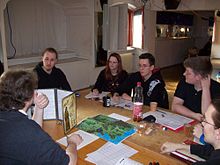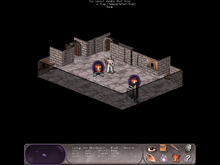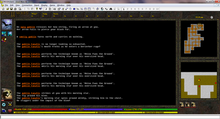Role-playing games are played in a wide variety of formats, ranging from discussing character interaction in tabletop form, physically acting out characters in LARP to playing characters virtually in digital media. There is also a great variety of systems of rules and game settings. Games that emphasize plot and character interaction over game mechanics and combat sometimes prefer the name storytelling game. These types of games tend to reduce or eliminate the use of dice and other randomizing elements. Some games are played with characters created before the game by the GM, rather than those created by the players. This type of game is typically played at gaming conventions, or in standalone games that do not form part of a campaign.
Tabletop

Tabletop and pen-and-paper (PnP) RPGs are conducted through discussion in a small social gathering. The GM describes the game world and its inhabitants. The other players describe the intended actions of their characters, and the GM describes the outcomes. Some outcomes are determined by the game system, and some are chosen by the GM.
This is the format in which role-playing games were first popularized. The first commercially available RPG, Dungeons & Dragons (D&D), was inspired by fantasy literature and the wargaming hobby and was published in 1974. The popularity of D&D led to the birth of the tabletop role-playing game industry, which publishes games with many different themes, rules, and styles of play. The popularity of tabletop games has decreased since the modern releases of online MMO RPGs.
This format is often referred to simply as a role-playing game. To distinguish this form of RPG from other formats, the retronyms tabletop role-playing game or pen and paper role-playing game are sometimes used, though neither a table nor pen and paper are strictly necessary.
Live action

A LARP is played more like improvisational theatre. Participants act out their characters’ actions instead of describing them, and the real environment is used to represent the imaginary setting of the game world. Players are often costumed as their characters and use appropriate props, and the venue may be decorated to resemble the fictional setting. Some live-action role-playing games use rock paper scissors or comparison of attributes to resolve conflicts symbolically, while other LARPs use physical combat with simulated arms such as airsoft guns or foam weapons.
LARPs vary in size from a handful of players to several thousand, and in duration from a couple of hours to several days. Because the number of players in a LARP is usually larger than in a tabletop role-playing game, and the players may be interacting in separate physical spaces, there is typically less of an emphasis on tightly maintaining a narrative or directly entertaining the players, and game sessions are often managed in a more distributed manner.
Electronic media

Tabletop role-playing games have been translated into a variety of electronic formats. As early as 1974, the same year as the release of Dungeons & Dragons, unlicensed versions of it were developed on mainframe university systems under titles such as dnd and Dungeon. These early computer RPGs influenced all of electronic gaming, as well as spawning the role-playing video game genre. Some authors divide digital role-playing games into two intertwined groups: single-player games using RPG-style mechanics, and multiplayer games incorporating social interaction.
Single-player
Single-player role-playing video games form a loosely defined genre of computer and console games with origins in role-playing games such as Dungeons & Dragons, on which they base much of their terminology, settings, and game mechanics. This translation changes the experience of the game, providing a visual representation of the world but emphasizing statistical character development over collaborative, interactive storytelling.
Multiplayer

Online text-based role-playing games involve many players using some type of text-based interface and an Internet connection to play an RPG. Games played in a real-time way include MUDs, MUSHes, and other varieties of MU*. Games played in a turn-based fashion include play-by-mail games and play-by-post games.
Massively multiplayer online role-playing games (MMORPGs) combine the large-scale social interaction and persistent world of MUDs with graphic interfaces. Most MMORPGs do not actively promote in-character role-playing, however, players can use the games’ communication functions to role-play so long as other players cooperate. The majority of players in MMORPGs do not engage in role-playing in this sense.
Computer-assisted gaming can be used to add elements of computer gaming to in-person tabletop role-playing, where computers are used for record-keeping and sometimes to resolve combat, while the participants generally make decisions concerning character interaction.